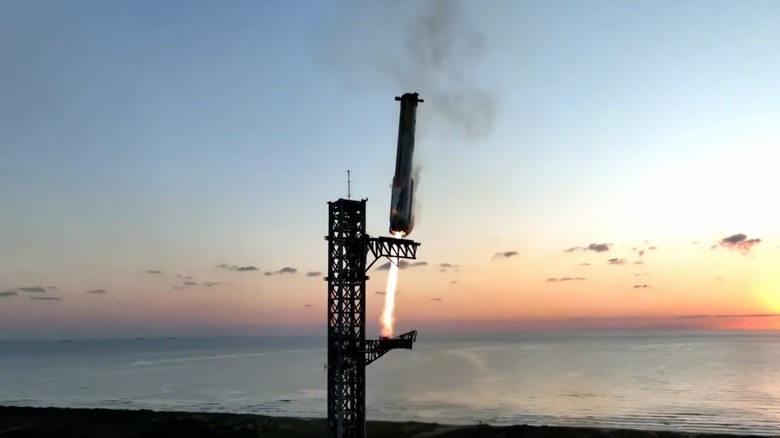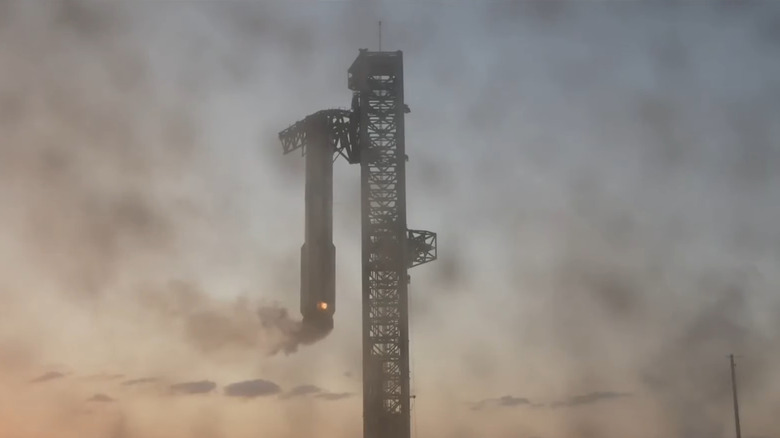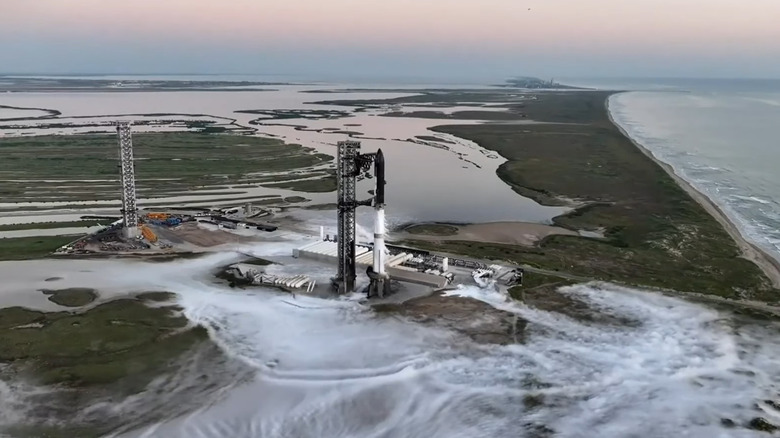Why SpaceX Ditched Landing Gear For 'Chopsticks' On Starship
SpaceX had its fifth launch of its Starship on October 13 from its Starbase site in South Texas. The main objective of the mission was to test the Mechazilla launch tower, as it is called. The tower has two metal arms, or chopsticks, designed to catch the spacecraft's Super Heavy booster.
The chopsticks worked as intended. Approximately seven minutes post-liftoff the Super Heavy booster started hovering in the proximity of the Mechazilla launch tower and was then perfectly caught by the tower's chopstick arms. This was met with cheers from the SpaceX team, and probably millions of people around the world who witnessed live what might be one of the most important SpaceX missions of all time.
"This is a day for the engineering history books," stated Kate Tice, SpaceX manager of Quality Systems Engineering, during a live broadcast from Space.com. "This is absolutely insane! On the first-ever attempt, we have successfully caught the Super Heavy booster back at the launch tower," Tice added.
Why was this such a significant feat, though? And why did SpaceX ditch landing gear for chopsticks? Here's what you need to know.
Why is Mechazilla so important for SpaceX?
Elon Musk, the billionaire founder and CEO of SpaceX, spoke excitedly about Mechazilla when it was still being built, but warned that the probability of the mechanism working on the first try was low.
"When the engines land ... it's gonna drop the velocity to basically zero and come in between the arms. The arms will be wide, and as it's coming in, the arms will close, go flush against the side of the vehicle, and the vehicle will be descending through the arms. The probability is uncertain, but it is above zero," he said at the time (via X).
As it turns out, Mechazilla's first real test was a success in more ways than one, as the 400-foot structure has the potential to change space travel forever. The fact that it can catch the booster midair and immediately position it back onto the launch mount could allow SpaceX to reuse it within a short time frame, thus increasing launch frequency and cutting costs.
This should allow SpaceX to make significant advancements at a more rapid pace, potentially accelerating the timeline for Musk's Mars plans, which include bombs, bubbles, Cybertrucks, and new species.
Broader implications of Mechazilla's success
Another significant breakthrough took place on October 13: SpaceX managed to bring Starship's upper stage to Earth with a splashdown in the Indian Ocean. This is not only good news for SpaceX, but also for NASA, since SpaceX is expected to participate in the Artemis program by transporting a crew of astronauts to the moon's south pole.
NASA Administrator Bill Nelson acknowledged SpaceX's success in a post on X, congratulating Musk and his team.
"Congratulations to SpaceX on its successful booster catch and fifth Starship flight test today! As we prepare to go back to the Moon under Artemis, continued testing will prepare us for the bold missions that lie ahead — including to the South Pole region of the Moon and then on to Mars," Nelson wrote.
It remains to be seen how the collaboration between SpaceX and the national space agency will develop, but Musk has big plans, even if he might not be willing to publicly discuss the concerns some have raised about SpaceX, ranging from their potential environmental impact of his projects to the labor complaints SpaceX employees have filed over the years.


